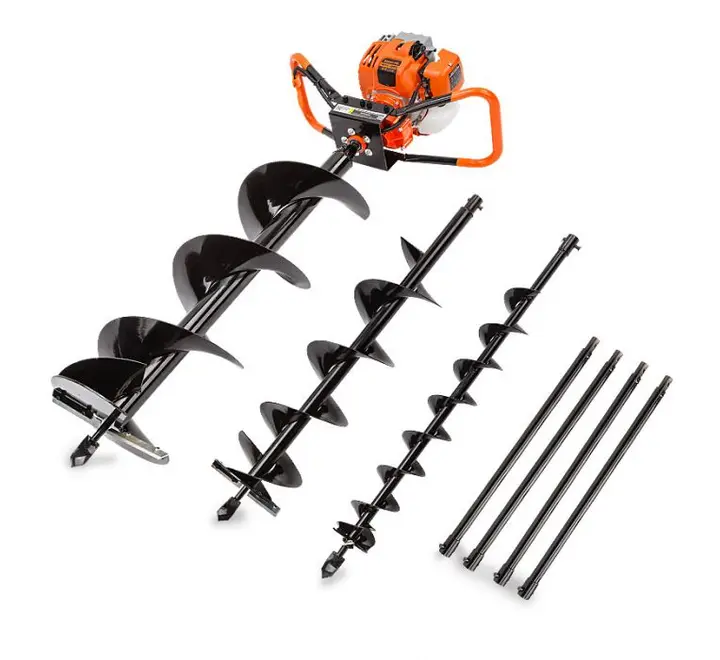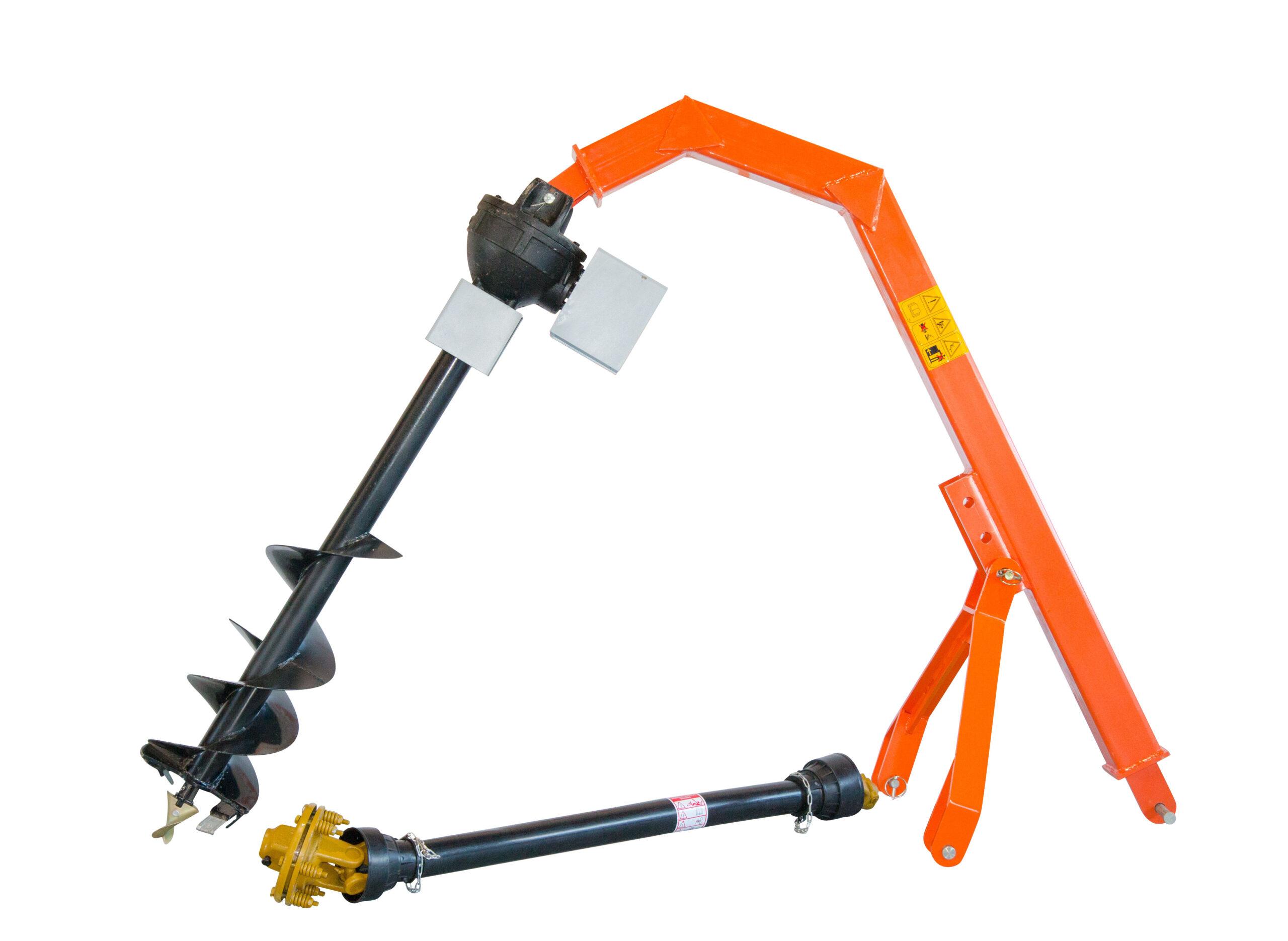Product Description
Popular , Suitable for 1 person operate model ,68cc engine Earth auger . φ25mm tube , Adjustable & foldablehandle handle with wheel is main characteristic . Base on this design , could make package volume is small & easy to assy . Also after assy the handle ,the width is suitable for human mechanics, easy to control. it could be a wheel barrow too . Max drive ability is ≤ φ 300mm auger bit . The most popular package way is Earth auger with manual , tool kits and other attached accessories of the earth auger, packaged in 1 carton/ color box . Each pcs auger bit pakcage by each carton .
This machine Max drive ability : ≤ φ 300mm auger bit , but we recommend drive :≤φ 250mm auger bit . Becasue of there are more diffirent model auger bits can match with this machine. so please check Auger bit in our website to choose the ideal model and size . then let us know , we will make offer
Wellcome to contact us to talk about more detials , Such as OEM , ODM and so on
| Feature: | 2-Stroke |
|---|---|
| Bit Diameter(mm): | 300 |
| Style: | Hand Push with Stand Type |
| Power Source: | Petrol / Gas |
| Stand Design: | Foldable |
| Transport Package: | Carton |
| Samples: |
US$ 98/PCS
1 PCS(Min.Order) | |
|---|
| Customization: |
Available
| Customized Request |
|---|

Can you provide examples of projects or applications that require a post hole digger?
Post hole diggers are versatile tools that find application in various projects and tasks that involve digging holes. Here are some examples of projects or applications that commonly require the use of a post hole digger:
- Fence Installation: When installing fences, post hole diggers are essential for digging holes to secure the fence posts. Whether it’s a wooden, metal, or vinyl fence, a post hole digger allows for precise and consistent hole digging, ensuring the stability and longevity of the fence.
- Deck or Patio Construction: Building a deck or patio often involves setting support posts into the ground. Post hole diggers are used to excavate holes for these posts, ensuring that they are properly anchored and provide a solid foundation for the structure.
- Signage or Street Lighting Installation: In projects involving the installation of signage, street lights, or other outdoor fixtures, post hole diggers are employed to dig holes for the supporting posts. This ensures that the signs or lights are securely mounted and can withstand external forces and weather conditions.
- Landscaping and Gardening: Post hole diggers are useful for various landscaping and gardening tasks. They can be used to dig holes for planting trees, shrubs, or large plants, allowing for proper root growth and stability. Additionally, post hole diggers are employed in installing garden trellises, arbors, or pergolas.
- Flagpole Installation: When erecting flagpoles, post hole diggers are utilized to dig the holes for the flagpole base. This ensures that the flagpole stands upright and remains stable, even in windy conditions.
- Foundation Repair: In certain foundation repair projects, post hole diggers are employed to excavate holes around the foundation for the installation of support piers or foundation underpinning. These holes allow access to the foundation, facilitating the repair or reinforcement process.
- Utility Pole Placement: Post hole diggers are commonly used in utility pole installation, where holes need to be dug to accommodate the poles. This is crucial for the installation of power lines, telephone lines, or other utility infrastructure.
- Building Construction: Post hole diggers play a role in various construction projects, such as the installation of structural supports for small buildings, sheds, or pergolas. They are used to dig holes for the support posts, ensuring a stable and secure structure.
These examples demonstrate the diverse range of projects and applications where post hole diggers are essential tools. Whether it’s for residential, commercial, or industrial purposes, post hole diggers enable efficient and accurate hole digging, contributing to the successful completion of various construction, landscaping, and installation projects.

What safety precautions should be followed when using a post hole digger?
When using a post hole digger, it is essential to prioritize safety to prevent accidents or injuries. Adhering to proper safety precautions ensures the well-being of the operator and anyone in the vicinity. Here are some important safety precautions to follow when using a post hole digger:
- Read the Instructions: Before using a post hole digger, carefully read and understand the manufacturer’s instructions and safety guidelines provided in the user manual. Familiarize yourself with the specific operating procedures, recommended safety equipment, and any limitations or precautions associated with the digger.
- Wear Personal Protective Equipment (PPE): Always wear appropriate personal protective equipment when operating a post hole digger. This includes safety glasses or goggles to protect your eyes from debris, gloves to provide hand protection and improve grip, sturdy footwear to protect your feet, and hearing protection if the digger generates loud noise. PPE helps minimize the risk of injuries and enhances operator safety.
- Inspect the Digger: Before each use, inspect the post hole digger for any signs of damage, wear, or loose components. Check the handles, blades, auger, and fasteners to ensure they are in good condition and properly secured. Any damaged or worn parts should be repaired or replaced before operating the digger.
- Clear the Work Area: Clear the work area of any obstacles, debris, or tripping hazards before using the post hole digger. Remove rocks, branches, or other objects that could interfere with the digging process or cause accidents. Maintain a safe distance from bystanders or other workers in the vicinity to prevent accidental contact or injury.
- Call Utility Companies: Before digging, contact the relevant utility companies to identify the location of underground utilities such as gas lines, water pipes, or electrical cables. This helps prevent accidental damage to utility lines, which can pose serious safety risks. Follow any guidelines provided by utility companies for safe digging practices in proximity to their infrastructure.
- Use Proper Digging Techniques: Follow the recommended digging techniques provided by the manufacturer. Use controlled and steady movements to dig the hole, avoiding sudden or jerky motions. Do not force the digger beyond its capabilities or apply excessive pressure, as this can lead to instability or damage to the digger. Pace yourself and take breaks as needed to prevent fatigue.
- Watch for Underground Hazards: While digging, be vigilant for underground hazards that may not be visible, such as tree roots, rocks, or buried debris. These obstacles can cause the digger to become unstable or abruptly stop, leading to accidents or injuries. If you encounter any unexpected resistance or obstruction, stop digging and inspect the area before proceeding.
- Store Safely: After use, store the post hole digger in a safe and secure location, out of the reach of children or unauthorized users. Store it in an upright position or as recommended by the manufacturer to prevent accidental tripping or damage. Proper storage ensures that the digger remains in good condition and reduces the risk of accidents during handling or retrieval.
- Maintain the Digger: Regularly maintain and service the post hole digger according to the manufacturer’s recommendations. This includes cleaning, lubricating moving parts, inspecting for wear or damage, and replacing any worn or damaged components. Well-maintained equipment operates more safely and efficiently, reducing the risk of accidents.
By following these safety precautions, operators can minimize the risk of accidents or injuries when using a post hole digger. Prioritizing safety through proper equipment usage, wearing appropriate PPE, inspecting the digger, clearing the work area, identifying underground utilities, using proper digging techniques, watching for hazards, storing the digger safely, and maintaining the equipment ensures a safer working environment and promotes responsible operation.

How do post hole diggers handle variations in soil types and conditions?
Post hole diggers are designed to handle variations in soil types and conditions, allowing for effective hole digging across different terrains. Here’s how they address these variations:
- Blade Design: Post hole diggers typically feature blades or augers with different designs to accommodate various soil types. For example, some blades have pointed tips and aggressive cutting edges, which are suitable for penetrating hard or compacted soils. Other blades may have a more open design with wider spacing, allowing for easier soil removal in softer or looser soils.
- Auger Size: Post hole diggers come in different auger sizes, allowing for versatility in handling different soil conditions. Larger augers are suitable for digging in softer soils where more soil needs to be displaced, while smaller augers are better for compacted or rocky soils where more effort is required to penetrate the ground.
- Power Source: Motorized post hole diggers, such as gas-powered or electric-powered ones, provide additional power to handle variations in soil types and conditions. The increased torque and rotational force generated by the power source enable the auger blades to overcome resistance in challenging soils, including compacted soil, clay, or rocky terrain.
- Adjustable Depth: Some post hole diggers offer adjustable depth settings, allowing operators to dig holes of varying depths. This feature is particularly useful when encountering different soil layers or when specific hole depths are required for a particular application. Operators can easily adapt the depth setting to match the soil conditions they are working with.
- Operator Technique: The operator’s technique plays a significant role in handling variations in soil types and conditions. Experienced operators know how to adjust the pressure, angle, and rotational speed of the post hole digger based on the specific soil they are working with. They may modify their approach to account for variations in soil hardness, moisture content, or presence of rocks or roots.
- Additional Tools and Accessories: In some cases, additional tools and accessories can be used in conjunction with post hole diggers to address specific soil challenges. For example, soil auger extensions can be added to reach greater depths in deep or sandy soils. Soil loosening agents or water can be employed to soften or moisten the soil, making it easier to dig.
By incorporating these design features, adjusting settings, employing proper technique, and utilizing additional tools if necessary, post hole diggers can effectively handle variations in soil types and conditions. However, it’s important to note that extremely hard or rocky soils may still pose challenges even for post hole diggers. In such cases, alternative methods or specialized equipment may be required to complete the digging task successfully.


editor by CX 2023-11-28